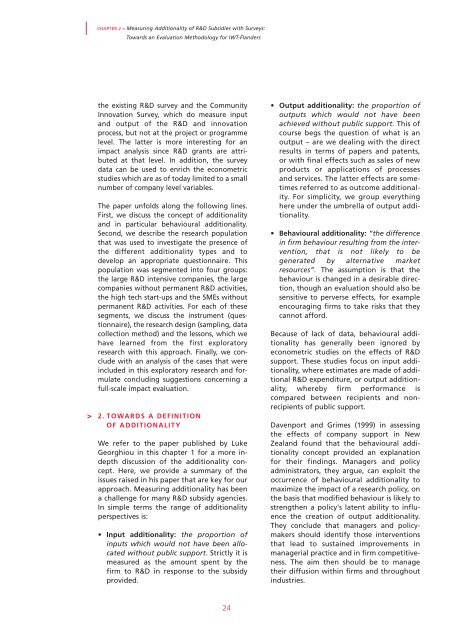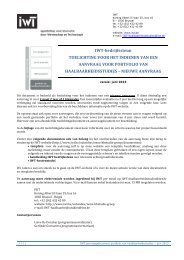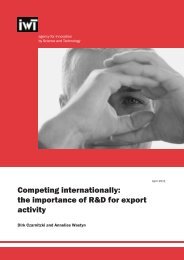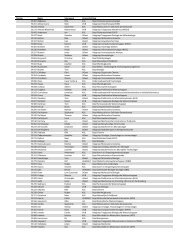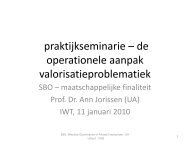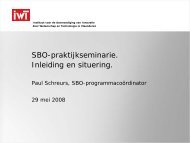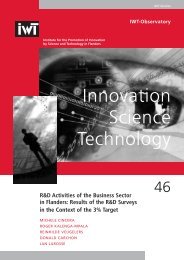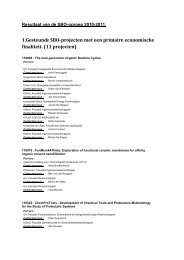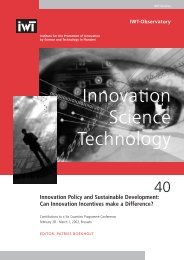The Evaluation of 'Behavioural Additionality' - IWT
The Evaluation of 'Behavioural Additionality' - IWT
The Evaluation of 'Behavioural Additionality' - IWT
Create successful ePaper yourself
Turn your PDF publications into a flip-book with our unique Google optimized e-Paper software.
CHAPTER 2 > Measuring Additionality <strong>of</strong> R&D Subsidies with Surveys:<br />
Towards an <strong>Evaluation</strong> Methodology for <strong>IWT</strong>-Flanders<br />
><br />
the existing R&D survey and the Community<br />
Innovation Survey, which do measure input<br />
and output <strong>of</strong> the R&D and innovation<br />
process, but not at the project or programme<br />
level. <strong>The</strong> latter is more interesting for an<br />
impact analysis since R&D grants are attributed<br />
at that level. In addition, the survey<br />
data can be used to enrich the econometric<br />
studies which are as <strong>of</strong> today limited to a small<br />
number <strong>of</strong> company level variables.<br />
<strong>The</strong> paper unfolds along the following lines.<br />
First, we discuss the concept <strong>of</strong> additionality<br />
and in particular behavioural additionality.<br />
Second, we describe the research population<br />
that was used to investigate the presence <strong>of</strong><br />
the different additionality types and to<br />
develop an appropriate questionnaire. This<br />
population was segmented into four groups:<br />
the large R&D intensive companies, the large<br />
companies without permanent R&D activities,<br />
the high tech start-ups and the SMEs without<br />
permanent R&D activities. For each <strong>of</strong> these<br />
segments, we discuss the instrument (questionnaire),<br />
the research design (sampling, data<br />
collection method) and the lessons, which we<br />
have learned from the first exploratory<br />
research with this approach. Finally, we conclude<br />
with an analysis <strong>of</strong> the cases that were<br />
included in this exploratory research and formulate<br />
concluding suggestions concerning a<br />
full-scale impact evaluation.<br />
2. TOWARDS A DEFINITION<br />
OF ADDITIONALITY<br />
We refer to the paper published by Luke<br />
Georghiou in this chapter 1 for a more indepth<br />
discussion <strong>of</strong> the additionality concept.<br />
Here, we provide a summary <strong>of</strong> the<br />
issues raised in his paper that are key for our<br />
approach. Measuring additionality has been<br />
a challenge for many R&D subsidy agencies.<br />
In simple terms the range <strong>of</strong> additionality<br />
perspectives is:<br />
• Input additionality: the proportion <strong>of</strong><br />
inputs which would not have been allocated<br />
without public support. Strictly it is<br />
measured as the amount spent by the<br />
firm to R&D in response to the subsidy<br />
provided.<br />
• Output additionality: the proportion <strong>of</strong><br />
outputs which would not have been<br />
achieved without public support. This <strong>of</strong><br />
course begs the question <strong>of</strong> what is an<br />
output – are we dealing with the direct<br />
results in terms <strong>of</strong> papers and patents,<br />
or with final effects such as sales <strong>of</strong> new<br />
products or applications <strong>of</strong> processes<br />
and services. <strong>The</strong> latter effects are sometimes<br />
referred to as outcome additionality.<br />
For simplicity, we group everything<br />
here under the umbrella <strong>of</strong> output additionality.<br />
• Behavioural additionality: “the difference<br />
in firm behaviour resulting from the intervention,<br />
that is not likely to be<br />
generated by alternative market<br />
resources”. <strong>The</strong> assumption is that the<br />
behaviour is changed in a desirable direction,<br />
though an evaluation should also be<br />
sensitive to perverse effects, for example<br />
encouraging firms to take risks that they<br />
cannot afford.<br />
Because <strong>of</strong> lack <strong>of</strong> data, behavioural additionality<br />
has generally been ignored by<br />
econometric studies on the effects <strong>of</strong> R&D<br />
support. <strong>The</strong>se studies focus on input additionality,<br />
where estimates are made <strong>of</strong> additional<br />
R&D expenditure, or output additionality,<br />
whereby firm performance is<br />
compared between recipients and nonrecipients<br />
<strong>of</strong> public support.<br />
Davenport and Grimes (1999) in assessing<br />
the effects <strong>of</strong> company support in New<br />
Zealand found that the behavioural additionality<br />
concept provided an explanation<br />
for their findings. Managers and policy<br />
administrators, they argue, can exploit the<br />
occurrence <strong>of</strong> behavioural additionality to<br />
maximize the impact <strong>of</strong> a research policy, on<br />
the basis that modified behaviour is likely to<br />
strengthen a policy's latent ability to influence<br />
the creation <strong>of</strong> output additionality.<br />
<strong>The</strong>y conclude that managers and policymakers<br />
should identify those interventions<br />
that lead to sustained improvements in<br />
managerial practice and in firm competitiveness.<br />
<strong>The</strong> aim then should be to manage<br />
their diffusion within firms and throughout<br />
industries.<br />
24


